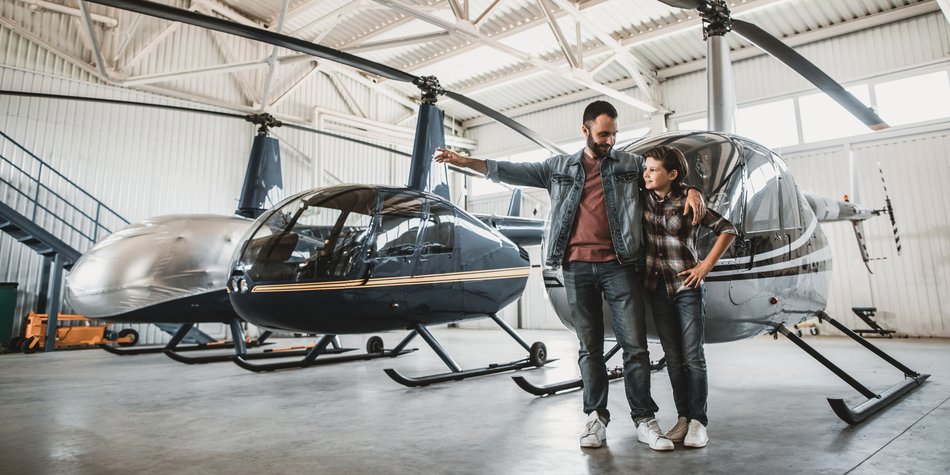
Help for helicopter parents: with these 7 tips you can support your child
Helicopter parents have a very bad reputation. We all immediately have a negative image in our minds and definitely don't want to be like that. But helicopter parents only mean (too) well with their children. Coach Astrid Meinberg explains how you can learn to let go and still be close to your children.
Helicopter parents create closeness and let go
Astrid Meinberg, herself a mother of three, was a manager in sales controlling for 20 years and, according to her own statement, managed to get through the family phase without any major damage and to remain relaxed despite all the challenges. After Passau, Singapore, Cologne, she has been living with her family in Hamburg for over 10 years and now supports other working women in online coaching sessions on their way to becoming mothers. Astrid writes for us about helicopter parenting and why letting go can create closeness:
Snowplough parents, lawnmower parents, clucking mothers, helicopter parents... there are now many names for this phenomenon. What do they all have in common? We are all parents, love our children and want only the best for them.
Parents wish their children only the best
What is best is very individual. And yet there are commonalities: The best should extend as far as possible to the whole of life, not just to the moment. We all want our children to be happy and successful, to be independent and get through life well, to find fulfilment in what they do, to develop their talents and use their potential... Until the end of their days. That they can lead a good life in their own individual way. And helicopter parents usually want this very badly!
Helicopter parents do not perceive the children's individuality
And at the same time, this helicopter strategy means that one loses sight of the individuality of the children: You drive ahead (with the imaginary lawnmower), focus on the surroundings instead of on the child, you can no longer see what the children actually need because of the imaginary flying height. Therefore, from these positions, despite all efforts, it is often not as easy as hoped to give the children the support they need most individually and specifically.
Helicopter parents do not recognise when the child needs more air to breathe than warmth and closeness. They may have good vision themselves, but they do not know the child's line of vision. So they may clear the wrong path to the wrong destination. It can happen that parents get lost and that the child is basically left helpless where it is.
Helicopter parents need to see their children
If we really want our children to be able to build a fulfilled and successful life for themselves, then in addition to "looking after our children" we also need a complementary strategy that allows us to recognise the child with its idiosyncrasies and to accept it with all its strengths and talents. A strategy that enables the child to dream its own dreams and set its own goals, so that it can optimistically go its own way and stay on the ball despite setbacks.
3 steps for helicopter parents to relax
So how can so-called helicopter parents reduce their "flight altitude", recognise with more closeness what their child needs at the moment and then, depending on the situation, choose what is really best for the child at the moment?
This requires three steps that can basically be helpful for all parents:
Step 1: Stand next to your child instead of in front of it or above it, so that you can create even more closeness. Helicopters hover over things and are therefore never really in contact with what they are observing with a lot of distance. If you come down in between and stand next to your child, in addition to getting an overview of the surroundings, you can also get an insight into your child's life. This will help you to see what your child needs in a specific situation.
Often children do not have the same perspective as you. Therefore, it is good that you bring in your perspective. At the same time, children have their own perception of the situation. In order to bring your insights to the child, it is helpful if you know exactly what their perception is and can then weave your view in like puzzle pieces.
Maybe you know when you read advice books and always feel that it's not working for you and your child? That's normal. You won't find in any book or guide exactly what is most important for your child. Only you can read that in your child. It helps you to be close to your child and to take his or her perspective.
When does the child need protection and help?
Step 2: Through proximity you can distinguish where your child needs protection and where it needs help. According to Haim Ohmer, one can divide the tasks of parents into "protecting" and "supporting". It is of course important that you "protect" your child and place yourself BEFORE your child when he or she is in such a risky situation that on the one hand he or she cannot cope with it on his or her own and on the other hand could suffer serious harm.
In this case, "pushing snow" or "mowing the lawn" may be very helpful. In all other situations, your primary task is to stand NEXT to your child, or perhaps even behind him/her. This way you can let them try to solve the situation themselves in an age-appropriate way. And because of the closeness you have to the child, you can still quickly give helpful impulses or even "protect" and intervene.
When cycling, for example, you first put your child on the back seat to protect it in traffic. When he rides himself, you first push him and hold him. But at some point you let go and run alongside, just supporting. Then at some point it is allowed to follow you, to follow your example. And later you let it go ahead, but always stay close behind it so that you can intervene and support it in an emergency. That's how they learn to make their own decisions. And when you know they can judge the traffic, you let them drive on their own. Depending on where your child is in its development, you protect or support it.
Helping them to help themselves
Step 3: Train your child's own "radar" so that they learn to recognise problems early and solve them themselves. All children sooner or later get into situations where we parents are no longer present to "protect" them. In order to be well equipped for these situations, your child needs a "radar of its own", so to speak, which gives it indications of when things could become dangerous instead of your parental care.
The best radar children have at their disposal is their own feelings. By helping our children to use their own feelings as a guide at an early age, we as parents can significantly support them in perceiving tricky situations in their everyday life as challenging at an early stage. If we are close to them and sensitively empathise with their perception, we can help them to train this "radar" well.
Then we can accept them with their uncomfortable feelings and teach them that these are an indication that they need to take good care of themselves now. And that they can listen to themselves to explore what they need right now to improve the situation for themselves. Only when they have learned to recognise this, will they be able to develop options for action themselves and choose the most promising one to overcome challenges.
Helicopter parents must learn to let go
Especially the third step - "training the radar" - is often not so easy for us. Especially because we usually haven't learned it well ourselves. Therefore, it can help to first apply this approach to yourself - exactly for the challenge we are discussing here: Doing the best for your child!
Questions you can ask yourself before the helicopter takes off
What is the worst that can happen? No danger to the integrity of your child? Then there is no need to protect.
Is your child strong and ready to deal with the situation? Yes? Then let it, observe and stay close to support at your child's request.
Does the strategy your child has chosen work? Great - your child has learned something for life, gained self-confidence and will come out stronger.
Doesn't it work? Then help him to look for alternatives, try again and only take the lead at the very last step. And if you do, explain to him that it just needs more practice and that it will work better next time.
Small steps... Give your child the chance to get a little closer to the solution each time. Ask them which piece they can do themselves.
What helicopter parents should practice
1) Notice the feeling: What feeling do you have when you start "helicoptering"? Fear of danger threatening the child, uncertainty about the best way to raise the child, fear of making mistakes that question you as a mother/father, fear of failure as a mother/father, fear of failure and failure of the child... What exactly is it with you? Example: You yourself are not so confident in dealing with strangers and are afraid that your child will be bullied at school.
2.) Clarify causes: What is causing this feeling right now? What goal are you threatening not to achieve? Which of your wishes is life running counter to right now? Example: You want your child to be strong, to do well at school and to make many friends.
3.) Consider alternative actions and choose the most helpful: What can you do to make the best possible progress towards this goal? Here I have two examples for you:
You accompany your child every step of the way and keep an eye on him/her, involve the teachers so that they keep an eye on your child and put other children in their place who behave inappropriately towards your child.
You strengthen your child at home, listen to his or her feelings and talk to him or her about them. If your child is also afraid of "bullying", you explore what he or she actually wants and give your child strategies on how to react in problematic situations. In this way, he or she becomes capable of acting and does not remain a "victim". You make sure that your child has a safe haven at home where it can always share all its worries with you and recharge its batteries so that it can step out into the world again, strengthened on the inside.
After reading the examples, think about: Which alternative will help you more to achieve your goal of your child being strong? And what reactions will your child's environment have to your behaviour? What does your child learn from your behaviour? What self-image do you convey to your child in each case? Of course, it remains YOUR judgement!
It is important that you are close to your child, that you also have an eye on what your child needs at the moment, and that your child can learn step by step to master his or her own challenges.
If you are worried about how your behaviour is affecting your children, you can always contact REDEZEIT FÜR FAMILIEN. Coaches are available here for a free consultation.

About the author:
As a coach, Astrid Meinberg supports mothers in finding their own way. This is to be found detached from social trends or apparent professional constraints. At REDEZEIT, Astrid also offers free support to all families who want to discuss their family concerns.
